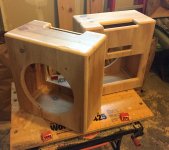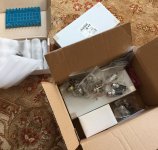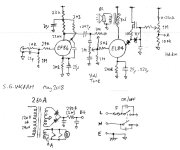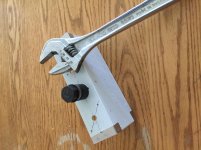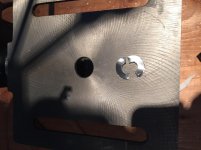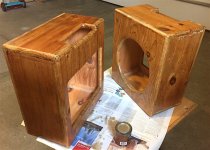Thanks - great input !
I made changes, they should be shown on the updated scheme - attached. I found another transformer in my junk box along with some chokes so I also updated the psu.
I like the changes in the schematic. It seems to give a darker feel.
I like Bigun's junk box, which seems to contain an endless supply of power transformers and filter chokes. He just reaches in, and out comes exactly what he needs.I like the changes in the schematic.
I think I once read a fairy-tale about a magic bag that always contained the thing you needed...Bigun seems to have found one of those!
Back on topic, is there any "voicing" going to be built into this amp, perhaps by choice of capacitor values?
-Gnobuddy
Member
Joined 2009
Paid Member
Ha! - well the junk box isn't quite enough. I did just order the two Hammond chassis.
Voicing - I've no idea, no experience or knowledge to bring to the table on this. My thinking is to leave the output stage non-voiced. As a pentode it will have a natural set of harmonics. I once build a spud amp using an EL84 (russian version) and it was noticeably different between triode and pentode mode. The pentode mode was more aggressive - a quality that I think a guitar amp favours.
I'm guessing it's a similar story for the EF86, it's natural harmonic structure as used by VOX is already good-as-is. The tone control after it is something I can play with, two caps to influence it's behaviour.
The 12AU7 boost input generates expectations of a signature tone, something cutting, so I'd assume it to have emphasized treble. I can play with the cathode bypass cap and the coupling cap to the next stage. Under-sizing them seems to be a popular choice.
Then there is the input load. With a high impedance input the pick-ups will have a treble peak. I'll leave that alone for the boost input. For the Normal input I could make the load switcheable, between say $80k (flat frequency response, but tone-sucking for some) and $1M (for normal peaky behaviour).
What do you fella's suggest ??
Voicing - I've no idea, no experience or knowledge to bring to the table on this. My thinking is to leave the output stage non-voiced. As a pentode it will have a natural set of harmonics. I once build a spud amp using an EL84 (russian version) and it was noticeably different between triode and pentode mode. The pentode mode was more aggressive - a quality that I think a guitar amp favours.
I'm guessing it's a similar story for the EF86, it's natural harmonic structure as used by VOX is already good-as-is. The tone control after it is something I can play with, two caps to influence it's behaviour.
The 12AU7 boost input generates expectations of a signature tone, something cutting, so I'd assume it to have emphasized treble. I can play with the cathode bypass cap and the coupling cap to the next stage. Under-sizing them seems to be a popular choice.
Then there is the input load. With a high impedance input the pick-ups will have a treble peak. I'll leave that alone for the boost input. For the Normal input I could make the load switcheable, between say $80k (flat frequency response, but tone-sucking for some) and $1M (for normal peaky behaviour).
What do you fella's suggest ??
Last edited:
Not the conventional answer, but I suggest putting a graphic EQ pedal between guitar and amp input, and tinkering with it to see if there is an EQ curve that your ears and brain like.What do you fella's suggest ??
If you find such a curve, do a frequency response measurement on the EQ pedal, and then put together circuitry to duplicate that curve in your amp.
I find an octave-wide notch a few dB deep at 800 Hz makes my electric guitars sound smoother and less harsh. I have absolutely no idea why, though.
You're dealing with a 'Tele, the guitar that's notorious for "icepick treble", and for permanent bad intonation if it has Leo's original design 3-barrel bridge. If the 'Tele is here to stay, I suspect that harshness-taming and treble rolloff might be things you might want to build into your amp.
But one person's "harshness" is another person's "chime", so who knows. Only your ears can tell you what you like!
-Gnobuddy
For use with choke input filter power supply a protection for over-voltage of 12AU7 during warm-up, before HT is stabilized.
I don't think you can kill a cold 12AU7 with 400V, 500V, even 600V.
As it starts to suck, the plate resistor will drop voltage quick enough.
The screen grid is still connected to a positive voltage in position #2, but the zener reduces the screen grid voltage.I suspect your EL84 won't work at all if the screen switch (I suppose it is?) is set to #2 - Low Power - position.
Best regards!
If there is enough screen grid current to make the zener behave, I think it will work.
-Gnobuddy
Member
Joined 2009
Paid Member
It might work, but not as intended. I need to swap around the networks between position 2 and 3. Then on position 2 (not connected) the screen is connected to HT via the zener and resistor (suitably sized to turn on the zener) and the when switched to position 3 it bypasses the zener for higher HT.
I've attacked the cabs with my roundover bit. I'm more than happy with the 1/2" size. The cabs are still rough looking - need to decide how to finish them. If I go with paint or something and want it all smooth then I need to fill the blemishes, if I go with the rustic look then I may leave the blemishes as they are since filler doesn't take stain very well.
I've attacked the cabs with my roundover bit. I'm more than happy with the 1/2" size. The cabs are still rough looking - need to decide how to finish them. If I go with paint or something and want it all smooth then I need to fill the blemishes, if I go with the rustic look then I may leave the blemishes as they are since filler doesn't take stain very well.
Attachments
I see the problem now. Kay was right. It's an easy fix, though. Remove the resistor on the right, connect it from point 2 to B+. That should work.It might work, but not as intended.
Wow, those rounded edges really transformed them! Nice going!I've attacked the cabs with my roundover bit.
-Gnobuddy
Member
Joined 2009
Paid Member
I was going to write "Christmas came early!", but perhaps "Spring came early!" would be more appropriate!The mailman came today.
-Gnobuddy
Member
Joined 2009
Paid Member
Hey - I got ceramic tube sockets, but not the type with restraining clips/springs. Since I'll be hanging the tubes upside down I figure I need these clips. Does anybody know if they are added to existing sockets or if I need to buy special sockets that restraining clips can be added to ?
My Super Champ XD has tube retainers that look like this: Amazon.com: Cary 4pc 8pin Vacuum Tube Retainer Socket Valve Clamp for Kt88 6l6 El34 5881 Gz34 6v6: Musical Instruments
The SCXD appears to have Belton plastic octal valve sockets ( Amazon.com: Cary 4pc 8pin Vacuum Tube Retainer Socket Valve Clamp for Kt88 6l6 El34 5881 Gz34 6v6: Musical Instruments ), and these spring retainers attach via the same two holes that retain the Belton octal socket.
I don't know if the mounting hole size and spacing is the same on your ceramic sockets as it is on the Belton's, though. I notice the Beltons appear to have a slightly slotted mounting hole to allow for minor imperfections in mounting hole position, which is a nice bit of engineering.
-Gnobuddy
The SCXD appears to have Belton plastic octal valve sockets ( Amazon.com: Cary 4pc 8pin Vacuum Tube Retainer Socket Valve Clamp for Kt88 6l6 El34 5881 Gz34 6v6: Musical Instruments ), and these spring retainers attach via the same two holes that retain the Belton octal socket.
I don't know if the mounting hole size and spacing is the same on your ceramic sockets as it is on the Belton's, though. I notice the Beltons appear to have a slightly slotted mounting hole to allow for minor imperfections in mounting hole position, which is a nice bit of engineering.
-Gnobuddy
From memory, that's exactly how the SCXD is put together - the socket is PCB-mounted, and mates up to a hole in the metal chassis from below. The spring retainer is on top of the chassis.Maybe it's just a matter of installing the sockets from beneath the chassis and the retainers on top of it.
Sorry for the bad link in my previous post, I mistakenly posted the same link twice. The Belton socket is this one: Socket - Belton, Micalex, 8 pin octal, MIP | Amplified Parts
-Gnobuddy
Member
Joined 2009
Paid Member
Well things just got really busy back in March and no progress has been made at all. I am going to try and make some progress again. I think a simpler approach is needed so I got some different power transformers - they are the smallest and lightest available from Hammond that give me the voltages I need as well as the flexibility to use the same trafo for the UK and Canada. The compromise is a little less current depending on how hot I run the trafo. And so I had to lose one of the tubes to save on current demand and keep it simple. If the gain is too low I will add a sand-pre stage.
I'm going to try a CRC supply instead of CLC to cut down on weight. The reality of how much stuff has to go into the little chassis has started to dawn on me now that I have some of the parts drawn out.
Attached is the simplified design. It's closer to the original design I posted, more VOX like. Even though gain is lower, the adjustable screen voltage on the output tube will allow the amp to be set up so that the front end can drive the output into distortion.
I'm going to try a CRC supply instead of CLC to cut down on weight. The reality of how much stuff has to go into the little chassis has started to dawn on me now that I have some of the parts drawn out.
Attached is the simplified design. It's closer to the original design I posted, more VOX like. Even though gain is lower, the adjustable screen voltage on the output tube will allow the amp to be set up so that the front end can drive the output into distortion.
Attachments
Last edited:
Member
Joined 2009
Paid Member
- Status
- This old topic is closed. If you want to reopen this topic, contact a moderator using the "Report Post" button.
- Home
- Live Sound
- Instruments and Amps
- Building a pair of valve combo-practice-amps
